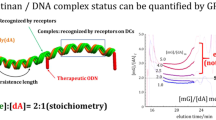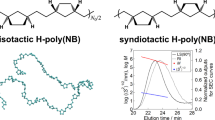Abstract
The double helix of a polysaccharide, xanthan was unwound by heating (denaturation) and rewound by cooling (renaturation) in acidic (0.01 M HCl) and basic (0.01 M NaOH) solutions. Circular dichroism spectra of xanthan renatured in the acidic and basic solutions were similar to those of native xanthan, which suggests that the local helical structures of the renatured xanthan were recovered by renaturation. The changes in the molar mass and intrinsic viscosity of xanthan induced by renaturation in the acidic solution can be explained by the renaturation scheme in the neutral solution, as reported previously. (Matsuda et al. Polym. J. 41, 526-532, 2009). Both the molar mass and radius of gyration of xanthan in the basic solution were decreased by denaturation and renaturation, and the molar mass dependence of the radius of gyration was similar to that of native xanthan. This change can be explained by the formation of a hairpin structure during renaturation in the basic solutions.
This is a preview of subscription content, access via your institution
Access options
Subscribe to this journal
Receive 12 print issues and online access
$259.00 per year
only $21.58 per issue
Buy this article
- Purchase on Springer Link
- Instant access to full article PDF
Prices may be subject to local taxes which are calculated during checkout









Similar content being viewed by others
References
Norisuye T, Teramoto A. In Polymeric Materials Encyclopedia (ed. Salamone, JC) 8801-9 (RC Press, Boca Raton, USA, 1996).
Sato T, Norisuye T, Fujita H. Double-stranded helix of xanthan in dilute solution: evidence from light scattering. Polym J. 1984;16:341–50.
Sato T, Kojima S, Norisuye T, Fujita H. Double-stranded Helix of Xanthan in dilute solution: further evidence. Polym J. 1984;16:423–9.
Sato T, Norisuye T, Fujita H. Double-stranded Helix of Xanthan in dilute solution: dimensional and hydrodynamic properties in 0.1 M aqueous sodium chloride. Macromolecules. 1984;17:2696–2700.
Liu W, Sato T, Norisuye T, Fujita H. Thermally induced conformational change of Xanthan in 0.01 M aqueous sodium chloride. Carbohyd Res. 1987;160:267–81.
Liu W, Norisuye T. Order-disorder conformation change of Xanthan in 0.01 M aqueous sodium chloride: dimensional behavior. Biopolymers. 1988;27:1641–54.
Capron G, Brigand G, Muller G. About the native and renatured conformation of xanthan exopolysaccharide. Polymer. 1997;38:5289–95.
Oviatt HW Jr, Brant DA. Viscoelastic behavior of thermally treated aqueous Xanthan solutions in the semidilute concentration regime. Macromolecules. 1994;27:2402–8.
Kawakami K, Okabe Y, Norisuye T. Dissociation of dimerized xanthan in aqueous solution. Carbohydr Polym. 1990;14:189–203.
Matsuda Y, Bjiyajima Y, Sato T. Thermal denaturation, renaturation, and aggregation of a double-helical polysaccharide Xanthan in aqueous solutions. Polym J. 2009;41:526–32.
Matsuda Y, Sugiura F, Mays JW, Tasaka S. Atomic force microscopy of thermally renatured Xanthan with low molar mass. Polym J. 2015;47:282–5.
Matsuda Y, Sugiura F, Okumura KW, Tasaka S. Renaturation behavior of Xanthan with high molar mass and wide molar mass distribution. Polym J. 2016;48:653–8.
Matsuda Y, Okumura KW, Tasaka S. Molar mass dependence of structure of Xanthan thermally denatured and renatured in dilute solution. Polym J. 2018;50:1043–9.
Zhang L, Liu W, Norisuye T, Fujita H. Double-stranded helix of xanthan: Rigidity in 0.01M aqueous sodium chloride containing 0.01 N hydrochloric acid. Biopolymers. 1987;26:333–41.
Causse B, Spadini L, Sarret G, Faure A, Travelet C, Madern D, et al. Xanthan exopolysaccharide: Cu2+ complexes affected from the ph-dependent conformational state; implications for environmentally relevant biopolymers. Envir Sci Tech 2016;50:3477–85.
Matsuda Y, Ashizawa H, Fukui T, Akao R, Tasaka S. Fabrication of polymer structure among fibrous structure of poly(lactic acid) gel and improvement of physical properties. Macromol Chem Phys. 2018;219:1700317.
Sato T, Norisuye T, Fujita H. Triple helix of Schizophyllum commune polysaccharide in dilute solution. 5. Light scattering and refractometry in mixtures of water and dimethyl sulfoxide. Macromolecules. 1983;16:185–9.
Tomofuji F, Matsuo K, Terao K. Kinetics of denaturation and renaturation processes of double-stranded helical polysaccharide, xanthan in aqueous sodium chloride. Carbohydr Polym. 2022;275:118681.
Acknowledgements
This work was partially supported by MEXT Promotion of Distinctive Joint Research Center Program Grant Number# JPMXP 0621467946. The analysis of the samples was partly carried out with a JASCO J-720KS at the Instrumentation Center, The University of Kitakyushu. We thank Professor Takahiro Sato at the Open University of Japan who kindly provided the xanthan samples and the dialyzer and, allowed us to use the CD instrument. This work was supported by JSPS KAKENHI Grant Number 19H02773.
Author information
Authors and Affiliations
Corresponding author
Ethics declarations
Conflict of interest
The authors declare no competing interests.
Additional information
Publisher’s note Springer Nature remains neutral with regard to jurisdictional claims in published maps and institutional affiliations.
Rights and permissions
Springer Nature or its licensor (e.g. a society or other partner) holds exclusive rights to this article under a publishing agreement with the author(s) or other rightsholder(s); author self-archiving of the accepted manuscript version of this article is solely governed by the terms of such publishing agreement and applicable law.
About this article
Cite this article
Matsuda, Y., Saiki, R., Sato, K. et al. Thermal denaturation and renaturation of a double-helical polysaccharide xanthan in acidic and basic solutions. Polym J (2024). https://doi.org/10.1038/s41428-024-00892-y
Received:
Revised:
Accepted:
Published:
DOI: https://doi.org/10.1038/s41428-024-00892-y



